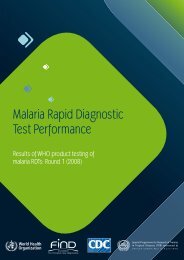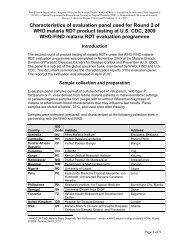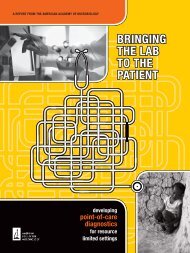MGIT TM Procedure Manual - Foundation for Innovative New ...
MGIT TM Procedure Manual - Foundation for Innovative New ...
MGIT TM Procedure Manual - Foundation for Innovative New ...
Create successful ePaper yourself
Turn your PDF publications into a flip-book with our unique Google optimized e-Paper software.
Section III: Drug Susceptibility Testing<br />
• X = Error – indeterminate results when certain conditions occur which may affect the<br />
test, such as GU of the control reaches >400 in less than 4 days. In such situations, the<br />
test should be repeated with pure, actively growing culture which is confirmed to be M.<br />
tuberculosis complex. Certain drug resistant strains grow very slowly in the medium<br />
and the results may not be achieved within 13 days with the standard inoculum. In such<br />
a case, the inoculum should be increased by decreasing the dilution of the culture<br />
suspension in order to get reportable results.<br />
7. Reporting<br />
Results must be reported as soon as they are available. When reporting results, it is<br />
important to include the name of the method used, the type of drug and its level of<br />
concentration.<br />
In case of resistance, check the medium visually and make sure that the test culture is not<br />
contaminated (look <strong>for</strong> turbidity and put 1 drop of the medium on an agar plate) or that the<br />
test culture belongs to N<strong>TM</strong>. In case of unexpected results or mono-resistance against<br />
Rifampin, PZA or Ethambutol, repeat the test to verify resistance.<br />
8. Quality control (QC)<br />
It is extremely important to per<strong>for</strong>m a quality control of drug susceptibility testing<br />
periodically. The minimum requirement is to test each new batch of reagents, such as SIRE<br />
drugs or <strong>MGIT</strong> medium. If the batch QC fails, all the results obtained within that batch, as<br />
well as the new batch of a reagent should be thoroughly reviewed and the testing should be<br />
repeated. Use M. tuberculosis H37Rv (ATCC [American Type Culture Collection] number<br />
27294) as a QC strain which is susceptible to all anti-tuberculosis drugs. It is not necessary<br />
to include a resistant strain, as most of the resistant strains against a drug which are available<br />
from ATCC and other culture collections are highly resistant and do not give any added<br />
benefit in the quality control. The test procedure <strong>for</strong> QC organisms is the same as described<br />
above <strong>for</strong> clinical isolates. The inoculum should be from a freshly grown culture in the<br />
<strong>MGIT</strong> medium or on LJ slant. In case the suspension of QC bacteria is made from growth on<br />
solid medium, follow the procedure <strong>for</strong> suspension preparation as described above. The<br />
suspension may be stored in aliquots frozen <strong>for</strong> up to 6 months at -70ºC+10ºC (<strong>for</strong> details of<br />
QC strain preparation see Section II-K-2).<br />
B. Pyrazinamide (PZA) Susceptibility Testing<br />
1. Introduction<br />
Susceptibility testing against PZA is always carried out at a lower pH of the medium, since<br />
pyrazinamide (PZA) is active only at the low pH in vitro. There are two methods widely<br />
used <strong>for</strong> PZA susceptibility testing. In the proportion method, Middlebrook 7H10 agar<br />
medium at pH 5.5 is used, with 25-50 µg/ml PZA. Colony counts, on the drug-free and drug-<br />
<strong>MGIT</strong> <strong>TM</strong> <strong>Procedure</strong> <strong>Manual</strong> 47




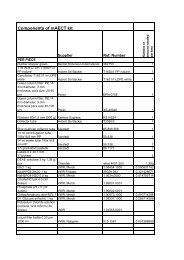
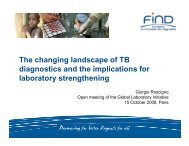
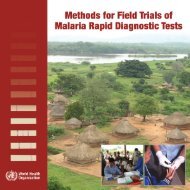
![Download in English [pdf 2Mb] - Foundation for Innovative New ...](https://img.yumpu.com/49580359/1/184x260/download-in-english-pdf-2mb-foundation-for-innovative-new-.jpg?quality=85)

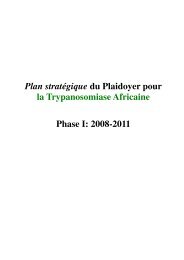
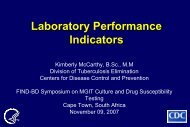
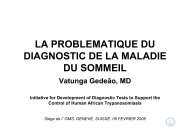
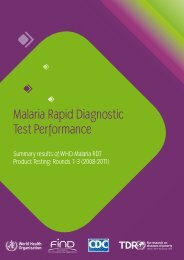
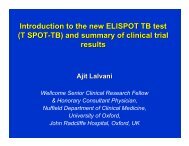
![New laboratory diagnostic tools for tuberculosis control [.pdf]](https://img.yumpu.com/43339906/1/190x135/new-laboratory-diagnostic-tools-for-tuberculosis-control-pdf.jpg?quality=85)
